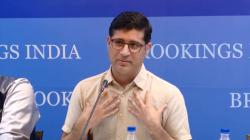Content from the Brookings Institution India Center is now archived. After seven years of an impactful partnership, as of September 11, 2020, Brookings India is now the Centre for Social and Economic Progress, an independent public policy institution based in India.
This work was part of the larger research on land and property rights supported by the Omidyar Network.
This is a tentative and an exploratory analysis to assess the productivity of the Supreme Court of India (SC) under different Chief Justices of India (CJI) in terms of accomplished adjudications, which is its core function. In particular, we study the number of judgements passed by the apex court per day during the tenure of a CJI and its relationship with the proportion of tenure days when at least one judgement was passed by the SC. Our analysis is for the time period of January 26, 1950, until the September 2, 2019. It is important to mention upfront that important questions regarding jurisprudence, quality of judgement and independence of judiciary are beyond the scope of this paper.
Some key observations:
- Over this period, the Supreme Court of India has had 46 Chief Justices. We analyse the tenure of each CJI to study the productivity of the apex court and how it varied across CJIs.
- The Indian Parliament increased the number of Judges in the Supreme Court of India from 8 in 1950 to 11 in 1956. This was further increased to 14 in 1960, 18 in 1978 and 26 in 1986.
- Accomplished adjudications (Judgements passed): A total of 51,534 judgements have been passed by the SC during this 69-year period. The lowest number of judgements, 48, were passed during the tenure of CJI Amal Kumar Sarkar, who was in office from March 16, 1966 to June 29, 1966. The highest number of judgements, 7069, were passed by the SC during the tenure of CJI K G Balakrishnan who was in office from January 14, 2007 to May 12, 2010. The average number of judgements passed during the tenure of a CJI is 1120 and the standard deviation [SD] was 1311.
- Length of tenure: There is significant variation in the length of tenure of a CJI. CJI Kamal Narain Singh was in office from November 25, 1991 to December 12, 1991, a total of 17 days. CJI Y V Chandrachud, on the other hand, was in office from February 22, 1978 to July 11, 1985, a total of 2696 days (or a little over seven years). The mean tenure of a CJI was approximately 552 days and the standard deviation was approximately 503.
- Number of judgements passed per day: We find variations in the number of judgements passed per day by the SC under tenure of a CJI. For example, during the tenure of CJI H J Kania, who was in office from January 26, 1950 to November 6, 1951, a total of 649 days, the SC passed a total of 128 judgements at the rate of approximately 0.20 (128/649) judgements per day of his tenure. At the other end of the distribution is the tenure of CJI K G Balakrishnan. He was in office for 1214 days, when a total of 7069 judgements were passed by the SC at the rate of approximately 5.82 (7069/1214) judgments per day. The average ‘Number of Judgements Passed by the SC per day’ over tenures of all CJIs during the period of the study was 2.24 with SD of 1.35. We present the results for each CJI in Figure 1.
- Proportion of ‘Judgement days’: Next, we analyse the variations in the proportion of tenure days when at least one (one or more) judgements were passed by the SC during a CJI’s tenure. For example, during the tenure of CJI Y V Chandrachud who was in office for 2696 days, there were 1106 days when at least one judgement was passed by the SC. Therefore, the proportion of ‘judgement days’ during CJI Y V Chandrachud’s tenure was approximately 0.41 (1106/2696). This means that 41% of days under his tenure saw at least one accomplished adjudication by the Supreme Court of India. The remaining 59% days under his tenure saw no accomplished adjudication by the SC. We call this variable ‘Proportion of Judgement Days’ under a CJI. The average proportion of Judgement Days across all CJIs was 0.45 and the SD is 0.12. This is presented in Figure 2.
Figure 1: Number of Judgements Passed by SC per Day under Each CJI
Figure 2: Proportion of Judgement Days to Total Days in CJI Tenure
7. Productivity of Supreme Court of India: To understand the dynamics of productivity (narrowly defined as the total number of judgements passed per day by the SC), we scrutinise the relationship between number of judgements passed per day by the SC (under a given CJI) and the proportion of judgment days when at least one judgement was passed by the SC (under a given CJI). We present this relationship in Figure 3.
Figure 3: Productivity Increasing with Proportion of Judgement Days
In order to derive this relationship, we ran the following regression:
What does the above relationship mean? The observed relationship between the number of judgements passed per day by the SC under a CJI and the proportion of judgement days under that CJI means the following:
a) Number of judgements passed per day by the SC under a CJI is increasing at an increasing rate with the proportion of judgement days under that CJI. The implications of this can be illustrated with the help of an example. Consider two CJIs (say CJIA and CJIB), both of whom have the same length of tenure, say 100 days. If the proportion of judgement days under CJIA was 0.5, while for CJIB it was 0.6 (so 20% higher than CJIA)– then the empirical relationship in Figure 3 would imply that the expected number of judgements passed per day by SC under CJIA would be approximately 2.7, while it would be much higher at 4.7 judgements per day under CJIB. That is, the number of judgements per day under CJIB would be approximately 74% higher than number of judgements per day under CJIA.
b) We also compute the elasticity (Ꜫ) between total number of judgements passed by SC per day and the proportion of judgement days in the tenure of a CJI. We define elasticity (Ꜫ) as the percentage change in total number of judgements passed by SC per day if there was a 1% increase in the proportion of judgement days in the tenure of a CJI. From the observed relationship we compute the following:
For example, we compare CJIA and CJIB who have the same length of tenure but differ in terms of the proportion of judgement days in their tenure. If the proportion of judgement days under CJIA is 0.5 while for CJIB it is 0.6, then a 1% increase in the proportion of judgement days under CJIA would imply an increase of approximately 2.8% in the total number of judgements passed by SC per day of tenure of the CJIA; while for CJIB, this increase would be approximately 3.4%. This implies that the elasticity is increasing with the proportion of judgement days under a CJI.
c) Based on this robust empirical relationship, we compute a counterfactual from the data: how many more total judgements would have been passed by the SC, if the proportion of judgement days were increased by 10%, given the existing lengths of CJI tenure? Our analysis reveals that approximately 14,359 additional judgements would have been passed by the SC if the proportion of judgement days increased by a mere 10%. This amounts to an increase of approximately 28% of the total SC judgements passed in the lifespan of the apex court since 1950.
d) We do not find a statistically significant relationship between bench strength (in terms of total number judges) and the number of judgements per day.
Conclusion
We analyse publicly available data for the Supreme Court of India to study the variations in its productivity over time under different Chief Justices of India. For reasons of data availability, this analysis is narrow in scope and limited to quantitative measures of productivity of the apex court. We define productivity using number of judgements per day and the proportion of judgement days under a given CJI. This productivity is likely to vary by the quantum of cases at the Supreme Court. Unfortunately, this data is not available, therefore, we standardise it only by the tenure length. While the number of Justices and the number of cases have changed substantially over time, it is interesting to note that the relationship does not vary linearly over time, and moreover, there is no significant relationship between bench strength and number of judgements per day. For example, the court productivity from 1990-2010 improved as compared to 1980 but declined after 2010. The empirical analysis reveals that number of judgements per day is primarily influenced by proportion of judgement days under a given CJI, there was no evidence that increased bench strength has any significant impact on number of judgements per day. The objective of this study is to initiate a set of broader empirical research and discussions to gain greater insights into the judicial administrative ecosystem of the apex court. These can contribute to informed and constructive interventions and needed judicial reforms in the country.
Data Source: India Kanoon website https://indiankanoon.org/. We also compared the number of SC judgements listed on the India Kanoon website with number of judgements listed on the Supreme Court website at https://sci.gov.in/judgments to determine the accuracy of the data. We could not find any discrepancy between the two websites for the random checks performed.
The Brookings Institution is committed to quality, independence, and impact.
We are supported by a diverse array of funders. In line with our values and policies, each Brookings publication represents the sole views of its author(s).










Commentary
Performance of the Supreme Court and tenure of Chief Justices of India: An observational analysis (1950 to 2019)
October 22, 2019